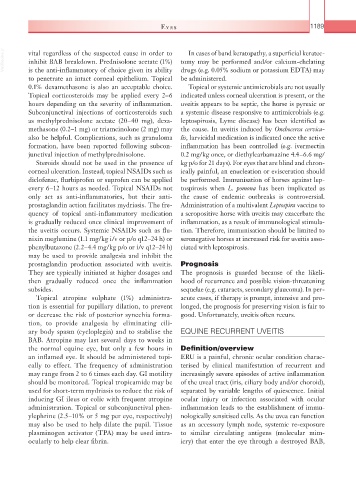Page 1214 - Equine Clinical Medicine, Surgery and Reproduction, 2nd Edition
P. 1214
Eyes 1189
VetBooks.ir vital regardless of the suspected cause in order to tomy may be performed and/or calcium-chelating
In cases of band keratopathy, a superficial keratec-
inhibit BAB breakdown. Prednisolone acetate (1%)
is the anti-inflammatory of choice given its ability
be administered.
to penetrate an intact corneal epithelium. Topical drugs (e.g. 0.05% sodium or potassium EDTA) may
0.1% dexamethasone is also an acceptable choice. Topical or systemic antimicrobials are not usually
Topical corticosteroids may be applied every 2–6 indicated unless corneal ulceration is present, or the
hours depending on the severity of inflammation. uveitis appears to be septic, the horse is pyrexic or
Subconjunctival injections of corticosteroids such a systemic disease responsive to antimicrobials (e.g.
as methylprednisolone acetate (20–40 mg), dexa- leptospirosis, Lyme disease) has been identified as
methasone (0.2–1 mg) or triamcinolone (2 mg) may the cause. In uveitis induced by Onchocerca cervica-
also be helpful. Complications, such as granuloma lis, larvicidal medication is indicated once the active
formation, have been reported following subcon- inflammation has been controlled (e.g. ivermectin
junctival injection of methylprednisolone. 0.2 mg/kg once, or diethylcarbamazine 4.4–6.6 mg/
Steroids should not be used in the presence of kg p/o for 21 days). For eyes that are blind and chron-
corneal ulceration. Instead, topical NSAIDs such as ically painful, an enucleation or evisceration should
diclofenac, flurbiprofen or suprofen can be applied be performed. Immunisation of horses against lep-
every 6–12 hours as needed. Topical NSAIDs not tospirosis when L. pomona has been implicated as
only act as anti-inflammatories, but their anti- the cause of endemic outbreaks is controversial.
prostaglandin action facilitates mydriasis. The fre- Administration of a multivalent Leptospira vaccine to
quency of topical anti-inflammatory medication a seropositive horse with uveitis may exacerbate the
is gradually reduced once clinical improvement of inflammation, as a result of immunological stimula-
the uveitis occurs. Systemic NSAIDs such as flu- tion. Therefore, immunisation should be limited to
nixin meglumine (1.1 mg/kg i/v or p/o q12–24 h) or seronegative horses at increased risk for uveitis asso-
phenylbutazone (2.2–4.4 mg/kg p/o or i/v q12–24 h) ciated with leptospirosis.
may be used to provide analgesia and inhibit the
prostaglandin production associated with uveitis. Prognosis
They are typically initiated at higher dosages and The prognosis is guarded because of the likeli-
then gradually reduced once the inflammation hood of recurrence and possible vision-threatening
subsides. sequelae (e.g. cataracts, secondary glaucoma). In per-
Topical atropine sulphate (1%) administra- acute cases, if therapy is prompt, intensive and pro-
tion is essential for pupillary dilation, to prevent longed, the prognosis for preserving vision is fair to
or decrease the risk of posterior synechia forma- good. Unfortunately, uveitis often recurs.
tion, to provide analgesia by eliminating cili-
ary body spasm (cycloplegia) and to stabilise the EQUINE RECURRENT UVEITIS
BAB. Atropine may last several days to weeks in
the normal equine eye, but only a few hours in Definition/overview
an inflamed eye. It should be administered topi- ERU is a painful, chronic ocular condition charac-
cally to effect. The frequency of administration terised by clinical manifestation of recurrent and
may range from 2 to 6 times each day. GI motility increasingly severe episodes of active inflammation
should be monitored. Topical tropicamide may be of the uveal tract (iris, ciliary body and/or choroid),
used for short-term mydriasis to reduce the risk of separated by variable lengths of quiescence. Initial
inducing GI ileus or colic with frequent atropine ocular injury or infection associated with ocular
administration. Topical or subconjunctival phen- inflammation leads to the establishment of immu-
ylephrine (2.5–10% or 5 mg per eye, respectively) nologically sensitised cells. As the uvea can function
may also be used to help dilate the pupil. Tissue as an accessory lymph node, systemic re-exposure
plasminogen activator (TPA) may be used intra- to similar circulating antigens (molecular mim-
ocularly to help clear fibrin. icry) that enter the eye through a destroyed BAB,

